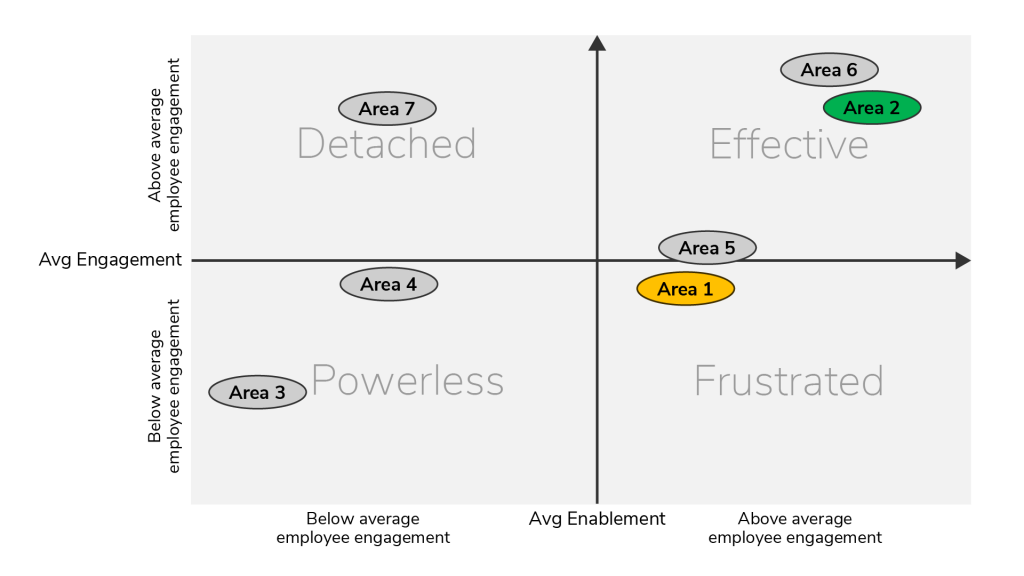Employee engagement has become increasingly mainstream in management thinking and employee research over the last decade. It proposes a mutually beneficial relationship between employer and employee – creating a win-win situation for both parties.
There is a lot of research that highlights some of the key benefits of engaged employees:
- Happiness and fulfilment
- Better performance
- Better results
There is also a lot of evidence that points to a correlation between how engaged people are at work and overall business productivity and performance.
Why you should also measure enablement
Measuring engagement is useful and helps build an understanding of employees’ emotional investment in your organisation. However, engagement is not the sole contributor to driving staff effectiveness. Engagement is only part of the story and any organisation wanting to develop also needs to understand how well it is enabling staff. Therefore, to provide a more holistic picture of the overall effectiveness of an organisation, it is important to measure both engagement and enablement.
To be effective employees need to be enabled. In other words, for people to be motivated at work they not only need to feel valued and engaged but also need to be supported in the right role and given the tools, equipment, technology, information and training to succeed in that role.
Engagement and enablement makes organisations more effective
Research illustrates that when high levels of staff engagement are combined with high levels of staff enablement, organisations achieve significantly improved results (up to 50% better productivity, 89% higher customer satisfaction and 54% better employee retention). Companies that effectively combine staff engagement and enablement also report significantly improved revenue growth, staff retention and staff performance.
Employees are most effective when they are both engaged and enabled. If they are engaged but not enabled this can lead to frustration (frustrated employees will go elsewhere if their concerns are not addressed). If they are given the tools to succeed but are not engaged they can become detached and those who are neither engaged or enabled feel powerless and lose morale and motivation and consequently are not as happy or productive as they could be.
By measuring both engagement and enablement you can get a clearer picture of how effective different parts of your organisation are and importantly how you can develop.

Here is a theoretical organisation’s results showing how effective different parts of the organisation are.
You can then combine these grouped scores and use the average to provide an overview of organisational effectiveness. Further analysis can provide specific tangible issues and improvements targeted for each area or overall as an organisation.
In the example above it might show that:
- area 1 is frustrated with training and development and feel that systems are inefficient
- area 3 does not feel valued by senior management, doesn’t feel well communicated with and are using out-of-date equipment
- area 7 do not feel their line manager respects or listens to them and they do not feel they are recognised or involved in issues that affect their job.
What should you ask to measure employee engagement?
The type of questions you can include to measure engagement include:
- Overall, how satisfied are you working for your organisation?
- I am proud to work for my organisation
- Working for my organisation motivates me to go beyond what is expected of me in my role
- I would recommend working for my organisation to others
- I feel valued by my organisation
What should you ask to measure employee enablement?
The type of questions you can include to measure enablement include:
- I have access to the materials and equipment I need to do my role well
- I have access to the technology I need to do my role well
- I have access to the information I need to do my role well
- Work processes and systems are efficient in my department
- I am trusted to make the choices and decisions necessary to do my role effectively
- My role makes good use of my skills and abilities
- I am appropriately involved in decisions that affect my work
- I receive the learning, training and development I require for my role
CJM Research is a full-service market research consultancy that helps you improve your business by making more informed decisions. Specialising in customer and employee satisfaction we have helped a broad range of clients understand and improve their customer and employee experience. Please get in touch with Callum if you would like to understand your business better.
We hope this helps.



